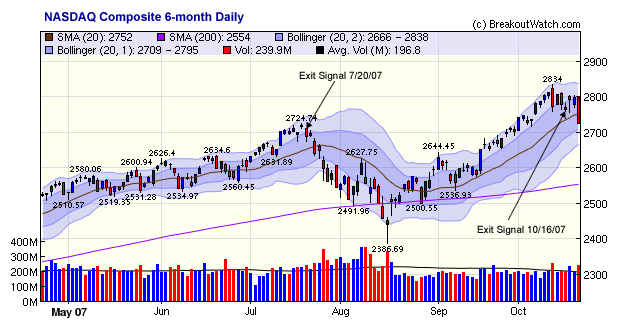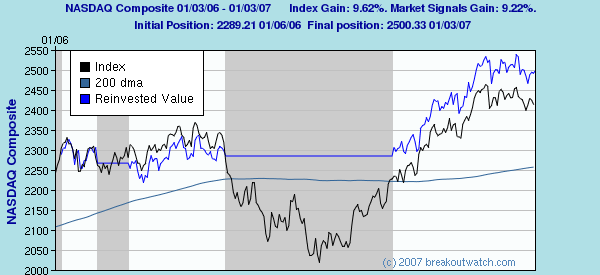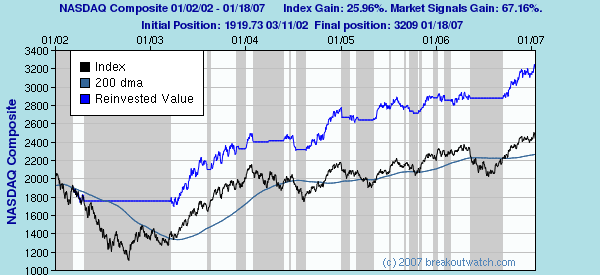| Market Summary | Weekly Breakout Report | Top Breakout Choices | Top 2nd Chances | New Features | Tip of the Week |
Market Summary
NASDAQ Market Signal Goes to Exit
Subscribers were given a warning of an impending market jolt when our market signal for the NASDAQ went to 'exit' on Tuesday this week. The NASDAQ is the most volatile of the three major indexes and weakness there usually carries over into the other major indexes. This was not the case earlier in the year when the other indexes were outperforming the NASDAQ, but market conditions are different now with there being a general realization that the economy is weakening, corporate profits are falling and the risks of recession are high. There is no longer optimism that consumer spending can be sustained indefinitely as the housing market continues to deteriorate and the strength of the major banks and Wall Street institutions are continuing to be questioned. For these reasons our confidence in the 'exit' signal is quite high, despite the rally in the index on Wednesday and Thursday.
Consistent with our recent comments that we expect the NASDAQ to outperform the broader indexes, the NASDAQ fared best this week with a loss of 2.87%. While this was steep, it bested the DJI and S&P 500 who lost 4.05 and 3.92% respectively. The number of successful breakouts fell to eleven, but they did post a positive gain by the end of the week.
While every market correction is different, and for different reasons, this one looks quite similar to the last major correction in the NASDAQ which began on 7/20 this year. The index had been rising in a trend bounded by the 1 and 2 standard deviation Bollinger Bands as it was recently. Our market model signaled an 'exit' the day after the high on 7/19 and from the open on 7/21 to the low on 8/16 the index lost 10.7%. Yesterday's close (10/19) looks a lot like the close on 7/24 when the index moved below the 20 day moving average

The fundamentals seem ripe for a drop of similar proportions now. Bloomberg news reports that: "S&P 500 companies have posted an average profit decline of 0.6 percent in the third quarter, the first drop since 2002, according to Bloomberg data. Twenty-seven percent of the 132 companies in the index that have reported results so far have trailed analysts' estimates, compared with 21 percent in the second quarter." With earnings for the 4th quarter likely to be further depressed, the outlook for stocks in the short to medium term does not look promising.
That said, we don't underestimate the power of the Fed, the Treasury and the big Wall Street firms to pull another rabbit out of the hat. One of the few bright spots the Administration can point to (and does frequently) is the stock market. They do not want a recession and market collapse heading into an election year and we could see another 0.5% interest rate cut when the FOMC meets on October 31, rather than the 0.25% cut that is currently expected.
No new features this week.
This week we reprise our newletter article from 120/07 for the benefit of those not familiar with the workings of our market model.
This week our market signal for the NASDAQ market reversed to 'exit'. This week we'll explain why and look at how the market signal performed over the last year and the last 5 years.
Market signals are generated by our Market Model based on distribution days and follow through days. A distribution day is one where the index closes down on higher volume than the previous day and follow through day is an accumulation day that occurs within a range of days (see below) after a market bottom. Note that our definition of a distribution day is clear cut and simple. This explains why our distribution day count on the NASDAQ this week climbed to five while a prominent investment daily only has the count at 3.
How the Market Model Works.
Each day after the market closes we look at the market movement for the day and assess whether the current signal should change.
If the current signal is 'enter', then we count the number of distribution days for each of the three major indexes over the last few trading sessions. We will issue an 'exit' signal if the number of distribution days exceeds a threshold as follows:
| Distribution Day Thresholds for Exit Signals | ||
Index |
Distribution Days |
No. Of Sessions |
|---|---|---|
DJI |
7 |
12 |
NASDAQ |
5 |
15 |
S&P 500 |
9 |
18 |
If the current signal is 'Exit', then we look for the day on which the index set its lowest intraday low since the last exit signal was issued and closed above that low. We'll call that 'day 1' of the recovery since it closed above the lowest low. We then look for a follow through day where the index closed at least 1.5% above the close on 'day 1' and volume exceeded the previous day's volume (an accumulation day). That follow through day must occur within a certain minimum and maximum number of days after day 1 as follows:
| Follow Through Day Limits | ||
Index |
Minimum Day No. |
Maximum Day No. |
|---|---|---|
DJI |
4 |
7 |
NASDAQ |
4 |
10 |
S&P 500 |
4 |
9 |
There is also an additional requirement that the close must be at least 0.05% above its 200 day moving average.
There is more information on how we built the model here.
How the Model worked in 2006
The model successfully avoided the large correction that began in May when it issued a sell signal on May 10. However, the requirement that a follow-through day can only occur if the index is above its 200 day moving average, meant that an enter signal was only issued on September 13, well after the market bottom. this significantly reduced the overall return and the model ended up breaking about even. The following chart shows the entry and exit points for 2006 and the returns for the index and the returns achieved if using the enter and exit signals. The 200 dma is also shown so you can see how the enter signal was delayed.

Model Performance Over 5 Years
Over the past five years the model has outperformed the NASDAQ Index by a factor of almost three:

Investment Advisors Using our Service
TradeRight Securities, located in a suburb of Chicago, is a full services investment management company and broker/dealer. They have been a subscriber, and user, of BreakoutWatch.com for some time now. They practice CANTATA and use Breakoutwatch.com as a “research analyst”. You can learn more about TradeRight Securities at: www.traderightsecurities.com. If you’re interested in speaking to a representative, simply call them toll-free at 1-800-308-3938 or e-mail gdragel@traderightsecurities.com.
Note to advisors: If you would like to be listed here, please contact us. As a service to those who subscribe to us, there is no additional charge to be listed here.
Get a 14 day free
Trial of our premium 'Platinum' service and TradeWatch.
No Credit Card Required.
Click
Here for 14 Day Free Trial |
| Index | Value | Change Week | Change YTD | Market1 Signal |
||||||||||||||||||||||||||||||||||||
|---|---|---|---|---|---|---|---|---|---|---|---|---|---|---|---|---|---|---|---|---|---|---|---|---|---|---|---|---|---|---|---|---|---|---|---|---|---|---|---|---|
| Dow | 13522 | -4.05% | 8.5% | enter | ||||||||||||||||||||||||||||||||||||
| NASDAQ | 2725.16 | -2.87% | 12.83% | exit | ||||||||||||||||||||||||||||||||||||
| S&P 500 | 1500.63 | -3.92% | 5.8% | enter | ||||||||||||||||||||||||||||||||||||
1The Market Signal is derived from our proprietary
market model. The market model is described on the site. 2The site also shows industry rankings based on fundamentals, combined technical and fundamentals, and on price alone (similar to IBD). The site also shows daily industry movements. |
||||||||||||||||||||||||||||||||||||||||
# of Breakouts
|
Period Average1
|
Max. Gain During Period2
|
Gain at Period Close3
|
|
|---|---|---|---|---|
| This Week | 11 | 13.46 | 5.16% | 0.38% |
| Last Week | 20 | 13.69 | 9.25% | -1.51% |
| 13 Weeks | 223 | 14.62 | 16.69% |
4.64% |
Sector
|
Industry
|
Breakout Count for Week
|
|---|---|---|
CONGLOMERATES
|
Conglomerates
|
1
|
CONSUMER NON-DURABLES
|
Rubber & Plastics
|
1
|
DIVERSIFIED SERVICES
|
Research Services
|
1
|
DRUGS
|
Drug Manufacturers - Other
|
1
|
ENERGY
|
Independent Oil & Gas
|
1
|
FINANCIAL SERVICES
|
Credit Services
|
1
|
FINANCIAL SERVICES
|
Asset Management
|
1
|
MATERIALS & CONSTRUCTION
|
Manufactured Housing
|
1
|
METALS & MINING
|
Steel & Iron
|
1
|
TELECOMMUNICATIONS
|
Wireless Communications
|
1
|
2This represents the return if each stock were bought at its breakout price and sold at its intraday high.
3This represents the return if each stock were bought at its breakout price and sold at the most recent close.
Category |
Symbol |
Company Name |
Expected Gain1 |
|---|---|---|---|
| Best Overall | EGO | El Dorado Gold Corp | 109 |
| Top Technical | DAR | Darling International | 80 |
| Top Fundamental | RIG | Transocean Inc | 22 |
| Top Tech. & Fund. | DAR | Darling International | 80 |
Category |
Symbol |
Company Name |
Expected Gain1 |
|---|---|---|---|
| Best Overall | CHB | Champion Enterprises Inc | 68 |
| Top Technical | PDGI | Pharmanet Dev Group Inc | 0 |
| Top Fundamental | TXT | Textron Inc | 42 |
| Top Tech. & Fund. | TXT | Textron Inc | 42 |
If you received this newletter from a friend and you would like to receive it regularly please go to the BreakoutWatch.com site and enter as a Guest. You will then be able to register to receive the newsletter.
Copyright © 2007 NBIcharts, LLC dba BreakoutWatch.com. All rights reserved.
" BreakoutWatch," the BreakoutWatch.com "eye" logo, and the slogan "tomorrow's breakouts today" are service marks of NBIcharts LLC. All other marks are the property of their respective owners, and are used for descriptive purposes only.